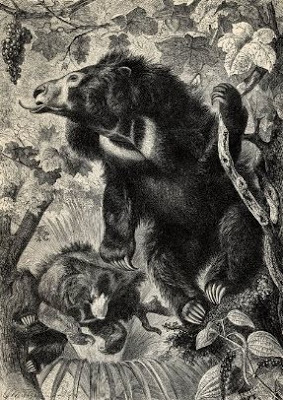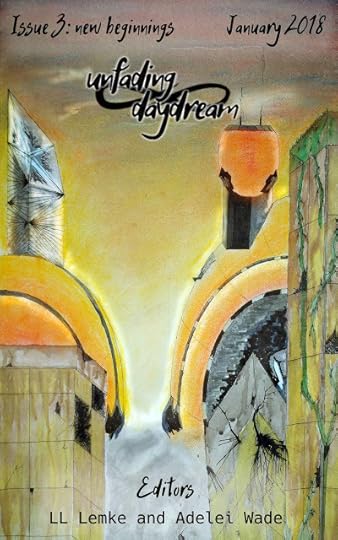Gordon Grice's Blog, page 11
June 4, 2018
Gut-Shot
Published on June 04, 2018 15:42
May 17, 2018
Water Torture: Full Graphic Novel (FREE!)

Water Torture: Full Graphic Novelby Parker Grice and Beckett Grice
A graphic novel of murder, burgers, and the roommate from Hell. Click the title to read. Rated R for violence, profanity, and disturbing themes.

Published on May 17, 2018 19:00
April 24, 2018
Guy Attacked by a Shark, Bear, and Rattlesnake

Honored to be quoted in Stephen Leahy's National Geographic article about a guy with amazingly bad luck. Of course, it's not all a matter of luck. The guy, one Dylan McWilliams, mentions that he likes to "catch rattlesnakes." That hobby comes with some risks.

Published on April 24, 2018 10:40
March 30, 2018
March 24, 2018
Human Babies Are Too Big to Swallow: A Tale of Snakes

When a species moves into a new place, things can get a little crazy. Case in point: the brown tree snake (Boiga irregularis) on Guam.
The story begins with scrap metal. Piled high in junkyards to await recycling, the scraps, with their many crannies and spaces, make ideal hiding places for rodents, rabbits, and lizards—and the snakes that prey on them. Snakes turn up in junkyards in almost every industrial place in the world. One fateful shipment of scrap metal and wooden crates arrived on the North Pacific island of Guam via airplane about 1948. It contained at least one brown tree snake. Probably it was a single gravid female. She became the ancestor of a whole population. For decades, the growing numbers of brown snakes on the island went unremarked. It was only when other wildlife began to disappear that people noticed the danger. Originally, the island was home to 18 species of birds. But the nightingale reed-warbler, a slender bird with a mohawk of feathers, vanished; and a sea bird called the brown noddy; and the Mariana crow, with its black feathers highlighted in blue and green. In all, fifteen bird species went extinct on the island. All of them had become common prey items for the brown tree snake.
The snake is quick and so lean its eyes seem to bulge from its head. The eyes have vertical pupils, like a cat’s. Despite its name, the snake is sometimes reddish or pale yellow rather than brown. In its native range of Papua New Guinea, the Solomon Islands, Indonesia, and part of the Australian coast, it rarely grows past six and half feet long. On Guam, however, it can reach almost ten feet. Scientists believe the difference is that Guam has virtually no predators capable of eating the snake. (The few exceptions, like the cane toad, only occasionally eat snakes, and then only the youngest ones.) In Australia, there are dozens of potential predators, from owls and kookaburras to other snakes. It’s hard to be certain which of these actually eat brown tree snakes, but at least one of them, the red-bellied black snake, has been witnessed doing so. Unfortunately, the redbelly’s venom makes it dangerous to humans, so it can’t be imported to control the invaders on Guam.
The brown tree snake glides among the branches of trees, sometimes dozens of feet high, searching for birds and their eggs. It seizes an unlucky bird in its mouth. If necessary, it also wraps around its prey to constrict it. Fangs in the rear of its mouth chew in a slow, paralyzing toxin. Death happens because the snake’s tightening coils prevent the bird from taking a breath or, if the bird lives long enough, because of the toxin. Then the snake swallows its victim whole. The toxin exists mostly to fight bacteria that might otherwise multiply as the bird decays in the snake’s gut. Its power to kill the prey is a secondary benefit.
Besides birds, the snake preys on bats (it has apparently exterminated two of the three native species) and lizards. And it has left other signs of its presence. Sometimes it climbs onto power lines, causing electricity to arc. The results are a power outage and a cooked snake. Some 1200 snake-related power outages have occurred on Guam in recent years, but these accidents have made no real dent in the snake population. The native animals continue to die. Having evolved on an island with few predators, they are slow to adapt to this invasive species. The loss of the animals has had far-reaching effects. Without the birds and bats to help pollinate them, certain plants have begun to decline. For example, there’s a type of mangrove tree that grows red flowers. On nearby islands, birds visit those flowers to sip their nectar. Once the bird sticks its beak in, the flower releases a tiny explosion of pollen. Some of that pollen clings to the bird’s beak and feathers as a fine dust. The next mangrove flower the bird visits can be fertilized by the pollen. When that happens, the flower produces fruit containing fertile seeds. On Guam, birds are no longer seen feeding from the mangrove flowers. New trees appear at a much slower rate. On the neighboring island of Saipan, it’s hard to count the trees because they crowd so closely. On Guam, it’s easy.
This kind of effect—with a new organism affecting others it doesn’t directly harm—is called an ecological cascade. The trees haven’t been the only victims of the cascade on Guam. Some of the missing birds and lizards ate insects. Without those controls in place, pest insects have bred in greater numbers, damaging fruit and vegetable harvests. Mosquitoes, especially, thrive without the insect-eating kinds of birds. As a result, the people of Guam suffered an outbreak of dengue, a sometimes fatal fever spread by mosquitoes.
Because they live mostly in the trees, the snakes are hard to spot. Many people visit Guam without ever seeing a snake. This doesn’t mean the snakes avoid people, however. They’ve been known to take eggs from the nests of domestic chickens and even kill pet birds in people’s houses. And, on occasion, they try to eat human babies.
Scientists have recorded at least eleven such attempts. Generally, the snake is found in bed with the child, who has been bitten and constricted. Because the brown tree snake slowly chews its venom into a victim, it is not especially dangerous to people who are big enough to run away or fight back. Only babies are small and defenseless enough to suffer life-threatening bites. Still, the slender snake is not large enough to swallow even these smallest humans. All the babies known to have been attacked this way have been rescued, though at least two needed artificial help breathing.
[I'm indebted to John C. Murphy's Secrets of the Snake Charmer for much of the information here, and to Max C. for pointing me toward this excellent book.]

Published on March 24, 2018 09:30
February 24, 2018
Sloth Bear vs. Polar Bear

Sloth bears are said to drive tigers away and to maul people when they feel crowded. Recently I came across a reference to an encounter that could only happen in captivity, and once again the mid-sized sloth bear proved surprisingly dangerous.
During the winter of 1897-98 an encounter took place between a polar bear and an Indian sloth bear at Sanger’s Circus, in which the latter came off an easy victor. It seems at first sight remarkable that such a powerful animal as a polar bear should have been so easily vanquished, but it was the cruelly long claws of the Indian that doubtless did the business, while the length and shagginess of his coat would protect him from the teeth and shorter talons of his northern antagonist.
--Richard Lydekker
The Game Animals of India, Burma, Malaya and Tibet (1907)

Published on February 24, 2018 09:00
January 27, 2018
Latest Publications: Some Lethal Essays

This Land’s newest anthology, the Faith Reader, is full of surprises, from Woody Guthrie’s religion to a lethal injection. My own contribution is a memoir called “A Stiller Ground,” which appeared in the magazine a few years back and was listed as a Notable Essay of the Year in Best American Essays 2014. What I love about This Land, aside from its devastating stories, is its commitment to keeping them alive. Through its multimedia website and anthologies like this one, the press stands behind its authors and their work. I should make clear that Faith Reader doesn’t advocate for any particular religious view. It explores, with open mind and a respect for diversity, many aspects of its topic.
Another fascinating foray into religion is the new Torah Encyclopedia of the Animal Kingdom by Natan Slifkin, a rabbi of extraordinary learning in both religion and the science of wildlife. His website, Biblical Natural History, always teaches me something about animals and the ways people try to understand them. Rabbi Slifkin isn’t merely a dusty scholar, however. His museum offers a hands-on wildlife experience.
 Illustration from The Torah Encyclopedia of Natural History, Vol. 1
Illustration from The Torah Encyclopedia of Natural History, Vol. 1
Published on January 27, 2018 09:00
January 13, 2018
My Latest Story in Unfading Daydream

Excited to announce the latest issue of Unfading Daydream, which features my lycanthropic short story “A Bowl of Beer.” The plot hearkens back to a Chinese folktale of the 3rd century, but I thought it would be cooler in modern-day Emporia, Kansas. I lived in Emporia years ago; my most vivid impression of it was how many people there were missing fingers. It had something to do with the meat-packing plant. Probably not what the chamber of commerce would prefer me to remember, so let me also mention that this is the home of Peter Pan Park, which the journalist William Allen White dedicated to his daughter after she died in a horse-riding accident. In my memory, that park is lit by fireflies.
Anyway, this third issue of Unfading Daydream contains 11 speculative tales of fresh starts and renewals. Authors include Donovan Bertch, Alice Godwin, Gordon Grice, Tim Jeffreys, Cate Millican, A.L. Nachtman, Charlotte Platt, Stephen Paul Sayers, Fanni Suto, Michael Thomas, and Olin Wish.

Published on January 13, 2018 09:00
January 6, 2018
Rural Scenes
 Paintings by John Constable
Paintings by John ConstableA Scene
By John Clare
The landscape’s stretching view, that opens wide,With dribbling brooks, and river's wider floods,And hills, and vales, and darksome lowering woods,With grains of varied hues and grasses pied;The low brown cottage in the shelter'd nook;The steeple, perking just above the treesWhose dangling leaves keep rustling in the breeze;And thoughtful shepherd bending o'er his hook;And maidens stript, haymaking too, appear;And Hodge a-whistling at his fallow plough;And herdsman hallooing to intruding cow:All these, with hundreds more, far off and near,Approach my sight; and please to such excess,That language fails the pleasure to express.




Published on January 06, 2018 09:00
December 8, 2017
Gordon Grice reveals which animals inflict worst deaths | Daily Mail Online
Pleased to be interviewed by Jennifer Newton of the Daily Mail for this provocative piece.


Gordon Grice reveals which animals inflict worst deaths | Daily Mail Online: "Expert reveals which animals inflict the worst deaths
MailOnline Travel here plays a safari animal death game of 'would you rather?'"


Published on December 08, 2017 16:52





